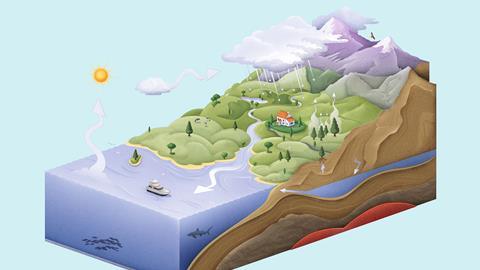Introduce the processes and the importance of the cycle to your 11–14 students with this poster and classroom activities
Materials are transported around the Earth in enormous cycles, driven by the Sun, gravity and life itself. Alongside the carbon cycle, nitrogen cycle and rock cycle, the water cycle contributes to the ever-changing face of our planet.
Without the water cycle, we wouldn’t have water to drink, food to eat or materials to build our homes. The water cycle describes the movement of 500 trillion tonnes of water around the Earth every year. Water on Earth is present as all three states of matter – solid, liquid and gas – and is continually going through physical state changes including evaporation, condensation, freezing and melting.
Download this
Infographic poster, fact sheet, worksheet, structure strip and teacher notes. Display the poster in your classroom or on a projector. Alternatively, print it and use it as a handout.
Use the accompanying fact sheet and worksheet to get your 11–14 students constructing their own model of the water cycle. Follow up with a long-answer question to check understanding and consider the water cycle in the context of chemistry, physics, biology and geography.
- Poster as pdf
- Fact sheet as MS Word or pdf
- Construct a model of the water cycle student worksheet as MS Word or pdf
- Construct a model of the water cycle teacher notes and answers as MS Word or pdf
- Movement of water structure strip as MS Word or pdf
- Movement of water structure strip teacher notes as MS Word or pdf
Evaporation – the Earth’s surface absorbs energy from the Sun, causing an increase in the rate of evaporation of surface water forming water vapour
Condensation – as the warm moist air rises through the cooler denser air above, the water vapour condenses, forming tiny water droplets which eventually form clouds
Precipitation – when the water droplets are large enough, they fall back to the Earth’s surface as rain, sleet or snow
Runoff – some of the water will run over the Earth’s surface, via streams and rivers, back to the sea
Percolation – some water will travel through the soil and rocks. It can remain as groundwater, transport back to the oceans, or be absorbed by plants
Transpiration – water is absorbed by plants via their roots and can be released as water vapour via their leaves, adding to the water vapour directly evaporating from the oceans
Did you know … ?
There are about 1.4 billion cubic kilometres of water on Earth, mostly found as a liquid in the oceans and other bodies of water (98.2%).
Evaporation and condensation
These processes can be seen in our everyday lives and are essential processes in the manufacture of everyday products.
Anywhere in the home where we use hot water, evaporation rates are high and there is lots of steam. Boiling pasta increases the concentration of water vapour in the kitchen. If we don’t use a good extractor fan or open the windows wide, the water vapour will condense on cool surfaces, especially windows and we end up with droplets of liquid water.
Teaching 11–14 students?
Then you might also like this poster, fact sheet and board game on the rock cycle.
If you want to make petrol from crude oil, alcoholic spirits from brewed liquids or flavourings for foods and perfumes, you need to use distillation. By collecting the evaporated components of a heated mixture, you can condense them back to liquids to separate fractions of the whole – we call this fractional distillation. Last year, some £30 billion worth of perfume was sold worldwide and chemists are at the centre of the whole development and production process.
Did you know … ?
Solid water can be found on Earth as ice and snow, mainly at the planet’s poles, and at the top of mountains.
Runoff and percolation
Water flowing over and through rocks changes the face of the planet and provides spectacular sights. Over millions of years, the Colorado river has been carving a path through Arizona, US, forming the Grand Canyon – a channel up to 29 kilometres wide and in places over 1800 metres deep. Water percolating through the rocks of the Peak District dissolves positive and negative ions out of the rocks. The water is collected, bottled and sold as Buxton Spring Water.
Did you know … ?
Water also transfers into the Earth’s mantle when tectonic plates get pushed under each other. This water will eventually re-emerge when volcanoes erupt!
More resources
- Use pollution in the water cycle as a context for teaching 7–9 year olds about seasonal changes with sustainability contexts for primary science.
- Add sustainable management of water to your existing lessons with these activities linked to UN Sustainable development goal 6.
- Boost your 11–14 students’ knowledge and understanding of evaporation with this poster, fact sheet and practical activity.
- Meet a laboratory analyst who helps ensure there is clean, safe, water for 15 million people in the UK while studying towards his chemistry degree.
All illustrations © Dan Bright
Downloads
Construct a model of the water cycle – student sheet
Handout | PDF, Size 0.64 mbConstruct a model of the water cycle – teacher notes
Handout | PDF, Size 0.51 mbMovement of water structure strip
Handout | PDF, Size 0.13 mbMovement of water structure strip – teacher notes
Handout | PDF, Size 0.15 mbWater cycle – fact sheet
Handout | PDF, Size 0.12 mbWater cycle – infographic poster
Handout | PDF, Size 0.9 mbConstruct a model of the water cycle – student sheet
Editable handout | Word, Size 1.58 mbConstruct a model of the water cycle – teacher notes
Editable handout | Word, Size 0.79 mbMovement of water structure strip
Editable handout | Word, Size 0.43 mbMovement of water structure strip – teacher notes
Editable handout | Word, Size 0.42 mbWater cycle – fact sheet
Editable handout | Word, Size 0.42 mb















No comments yet